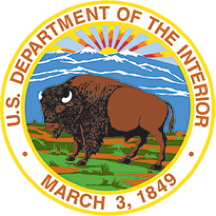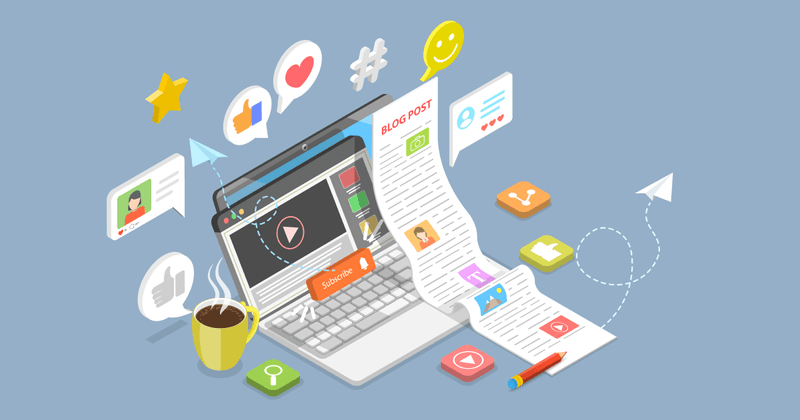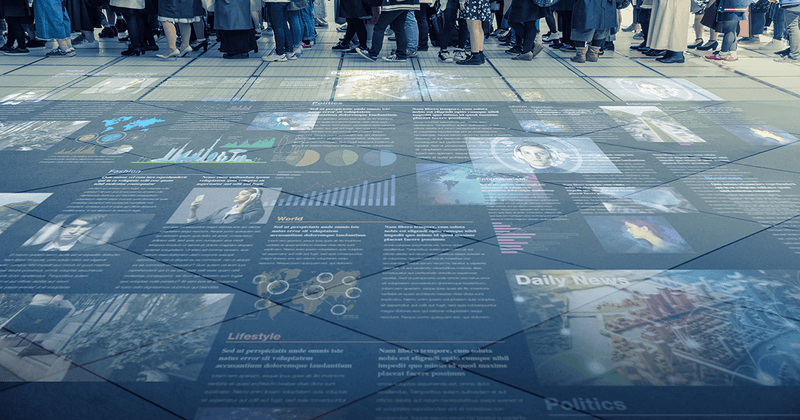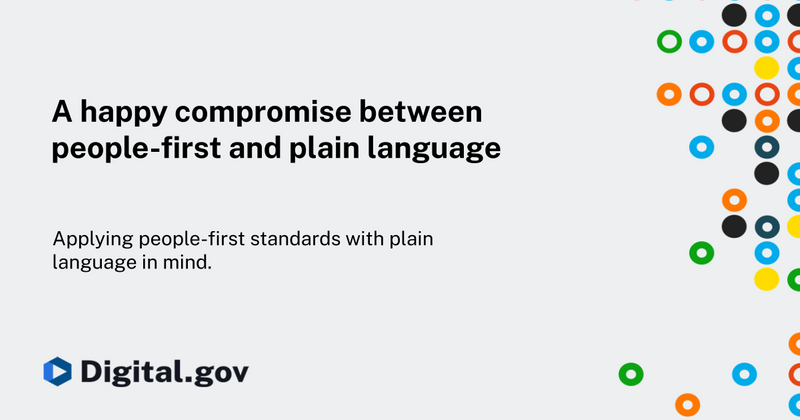Plain Language
Plain language is communication that is clear and easy to understand for your target audience, regardless of the medium used to deliver it. It is communication your audience can understand the first time they encounter it. Using plain language on government websites is one of the best ways to reach your target audience. A clear, concise message builds trust with users because they can understand your call to action and complete their tasks and meet their needs.
Related Policy
Plain Writing Act of 2010

Plain language: Essential knowledge
-
An introduction to plain language
Using plain language is required on all government websites and also creates a better user experience.
-
Plain language web writing tips
On the web, people are in a hurry. They skim and scan, looking for fast answers to their questions, so it’s important to get to the point—quickly.
-
Lessons from the 2021 Federal Plain Language Report Card
What we learned from examples of web content that received both high and low scores.
-
OMB Final Guidance on Implementing the Plain Writing Act of 2010 (M-11-15)
This memorandum provides final guidance on implementing the Act and is designed to promote the goals of the President’s Open Government Initiative.
Plain Language events
Strengthening information accessibility for consumers with limited English proficiency
The plain language tie to translating digital content
2022 Federal Plain Language Summit
Increase Your Impact With Plain Language
Plain Language news
Making the case for human-centered design: A Department of Justice case study
The Access DOJ initiative shares nine lessons on making services more accessible, effective, and efficient.
Simplifying manual accessibility testing: How plain language instructions drive compliance
Testing for accessibility ensures that digital services are usable for everyone. Explore how the Office of Natural Resources and Revenue (ONRR) streamlined their manual testing process with plain language instructions to create a more uniform testing methodology across their agency. By balancing detail with usability and continually updating resources, ONRR empowers both their small team and subject matter experts to meet Section 508 compliance.— via Office of Natural Resources Revenue

Introducing the Department of Homeland Security customer experience toolkit
The Department of Homeland Security’s Customer Experience Directorate developed a customer experience (CX) toolkit to help agencies implement CX strategies using a human-centered design approach. The toolkit offers resources to enhance service delivery, processes, and systems, following a “Ready, Set, Grow” framework for planning and implementation. It aims to serve as a reference for organizations bringing CX practices to their own agencies.— via Department of Homeland Security

Three tips for using meta descriptions
At USA.gov and USAGov en Español, the goal is to make content more useful to the public, and meta descriptions are one way to help people quickly find the government information they’re looking for. These brief summaries of webpage content appear in search engine results to entice users to click through, attracting visitors to agency websites. Regularly updating these descriptions based on user data can enhance their effectiveness. Read in more detail about their three tips to create effective meta descriptions: identify commonly searched keywords, write engaging and actionable descriptions, and ensure each one is unique.— via USA.gov

FEMA National Summit on Risk Communications, Crisis Communications, and Community Engagement
The Federal Emergency Management Agency Office of External Affairs is convening risk and crisis communicators and community leaders who are on the front-line of the climate and emerging hazard crises. Attend the free, June 10, 2024, summit virtually, or in Washington, DC. The agenda includes: the sharing invaluable tools and insights, how to implement culturally competent and accessible communications, how to integrate behavior change strategies, and more. An ASL interpreter will be provided.— via Federal Emergency Management Agency

Resources on Plain Language
-
An introduction to working with social media influencers
Learn how to partner with social media influencers and design, implement, and measure an influencer program.
-
An introduction to content
Best practices for creating clear, useful, digital content for federal websites and digital services.
-
PlainLanguage.gov
A resource to help federal employees write in plain language and comply with the Plain Writing Act of 2010.
-
An introduction to trust
Guidance on how to build government websites that people can trust.
-
An introduction to plain language
Understand how and why to use plain language on government websites and other digital services
-
Lessons from the 2021 Federal Plain Language Report Card
This event recap highlights best practices, a short case study video, and examples of federal web content that received both high and low scores in the 2021 Plain Language Report Card.
-
Multilingual Huddle: Designing for Translation
In this webinar, Laura Godfrey and Fedora Braverman share tips for translating content in the digital context.
-
An advanced approach to accessibility
A deeper look at accessibility: what to do, how to do it, and why it matters.
-
Bilingual Glossaries, Dictionaries, and Style Guides
Multilingual resources to standardize the use of various languages across government.
-
Requirements for delivering a digital-first public experience
Learn how to implement 21st Century IDEA to design and deliver better websites and digital services.
Tools and Services
-
PlainLanguage.gov
Guidance on the use of plain language for government communications and training for federal employees.
-
The Guide to the Paperwork Reduction Act
Get help with the PRA, planning and submitting an information request, and finding your agency’s PRA contact.
-
Open Opportunities
Discover opportunities across government that will help you build and make connections.
More News and Events on Plain Language
94 posts
Making the case for human-centered design: A Department of Justice case study
The Access DOJ initiative shares nine lessons on making services more accessible, effective, and efficient.
Simplifying manual accessibility testing: How plain language instructions drive compliance
Testing for accessibility ensures that digital services are usable for everyone. Explore how the Office of Natural Resources and Revenue (ONRR) streamlined their manual testing process with plain language instructions to create a more uniform testing methodology across their agency. By balancing detail with usability and continually updating resources, ONRR empowers both their small team and subject matter experts to meet Section 508 compliance.— via Office of Natural Resources Revenue

Introducing the Department of Homeland Security customer experience toolkit
The Department of Homeland Security’s Customer Experience Directorate developed a customer experience (CX) toolkit to help agencies implement CX strategies using a human-centered design approach. The toolkit offers resources to enhance service delivery, processes, and systems, following a “Ready, Set, Grow” framework for planning and implementation. It aims to serve as a reference for organizations bringing CX practices to their own agencies.— via Department of Homeland Security

Three tips for using meta descriptions
At USA.gov and USAGov en Español, the goal is to make content more useful to the public, and meta descriptions are one way to help people quickly find the government information they’re looking for. These brief summaries of webpage content appear in search engine results to entice users to click through, attracting visitors to agency websites. Regularly updating these descriptions based on user data can enhance their effectiveness. Read in more detail about their three tips to create effective meta descriptions: identify commonly searched keywords, write engaging and actionable descriptions, and ensure each one is unique.— via USA.gov

FEMA National Summit on Risk Communications, Crisis Communications, and Community Engagement
The Federal Emergency Management Agency Office of External Affairs is convening risk and crisis communicators and community leaders who are on the front-line of the climate and emerging hazard crises. Attend the free, June 10, 2024, summit virtually, or in Washington, DC. The agenda includes: the sharing invaluable tools and insights, how to implement culturally competent and accessible communications, how to integrate behavior change strategies, and more. An ASL interpreter will be provided.— via Federal Emergency Management Agency

Reconsidering the consent form: the least user-friendly aspect of UX research
The Open Data, Design, and Development (ODDD) team has replaced signed consent forms with a more accessible user research agreement process, offering multiple opt-in points. This ensures informed consent and participant autonomy. Explore why and how the ODDD team implemented this comprehensive participant consent process in their user research.— via Office of Natural Resources Revenue

How USAGov uses data to improve content
Each month, USAGov’s content designers spend many hours ensuring that the content on USA.gov and USAGov en Español is up-to-date, accurate, and meets user needs. Learn how their team does holistic reviews of each topic section based on a rolling calendar with the goal of updating all content at least every 6 months.— via USA.gov

Spring 2024 Community Summit
Delivering on 21st Century IDEA: A case study from the GSA SmartPay team (Part 3)
A GSA SmartPay product owner shares her experience designing user-centered, accessible content for multiple audiences.
Why the American People Deserve a Digital Government
OMB released new policy guidance for government that includes a variety of actions and standards to help federal agencies design, develop, and deliver modern websites and digital services. Memo M-23-22, Delivering a Digital-First Public Experience, will make it seamless for the public to obtain government information and services online, and help agencies fully implement the 21st Century Integrated Digital Experience Act (21st Century IDEA).— via The White House

A conversation about content audits
Content audits can be tedious. Two content designers discuss why we do them anyway, and how to get started.
Inclusivity and automation
Bots can help us improve our inclusivity by gently nudging us to use more appropriate language, explaining why some terms are offensive, and prompting us to consider others.
4 steps writers and editors can take to demonstrate value
As plain language writers and editors, we need to demonstrate the value we bring to projects. This writeup explains how to calculate the costs of our work and articulate its value.
Strengthening information accessibility for consumers with limited English proficiency
The art of storytelling in a hybrid world
Combined with technology and audience awareness, our increasingly digital, hybrid world can still leverage that in-person charm through the art of storytelling.
Plain language on onrr.gov: coordination and implementation with web content owners
Strategies, examples, and lessons learned from coordinating with content owners to enhance plain language on onrr.gov.— via Office of Natural Resources Revenue

The plain language tie to translating digital content
A happy compromise between people-first and plain language
Find out how the National Institute of Corrections is using people-first plain language in its communications. See what words and phrases they’re changing.
How to manage a federal website
Managing government websites is a targeted exercise. Here are 5 steps to help you build and maintain a successful one.
To Build Trust, Aim for Easy
Trust is earned through consistency and commitment. Build sites that build trust by considering user needs, respecting people’s time, and avoiding customer experience pitfalls.




















